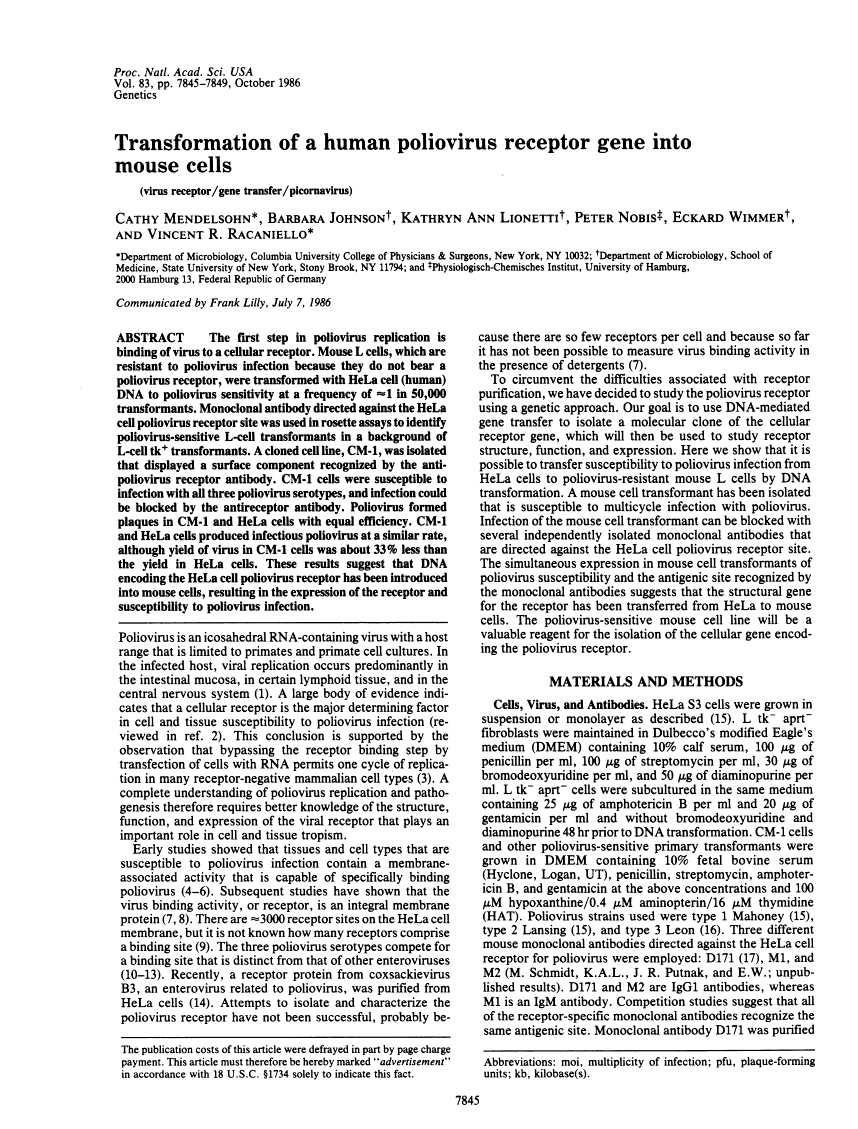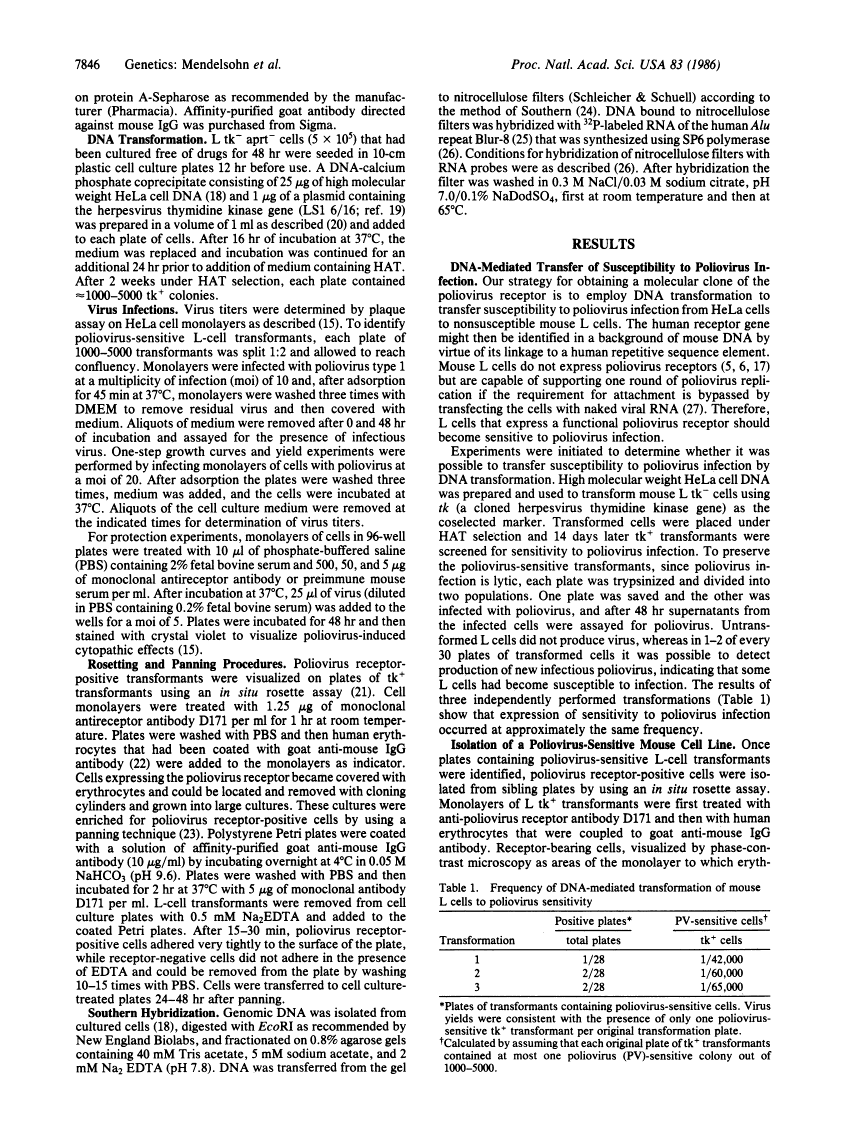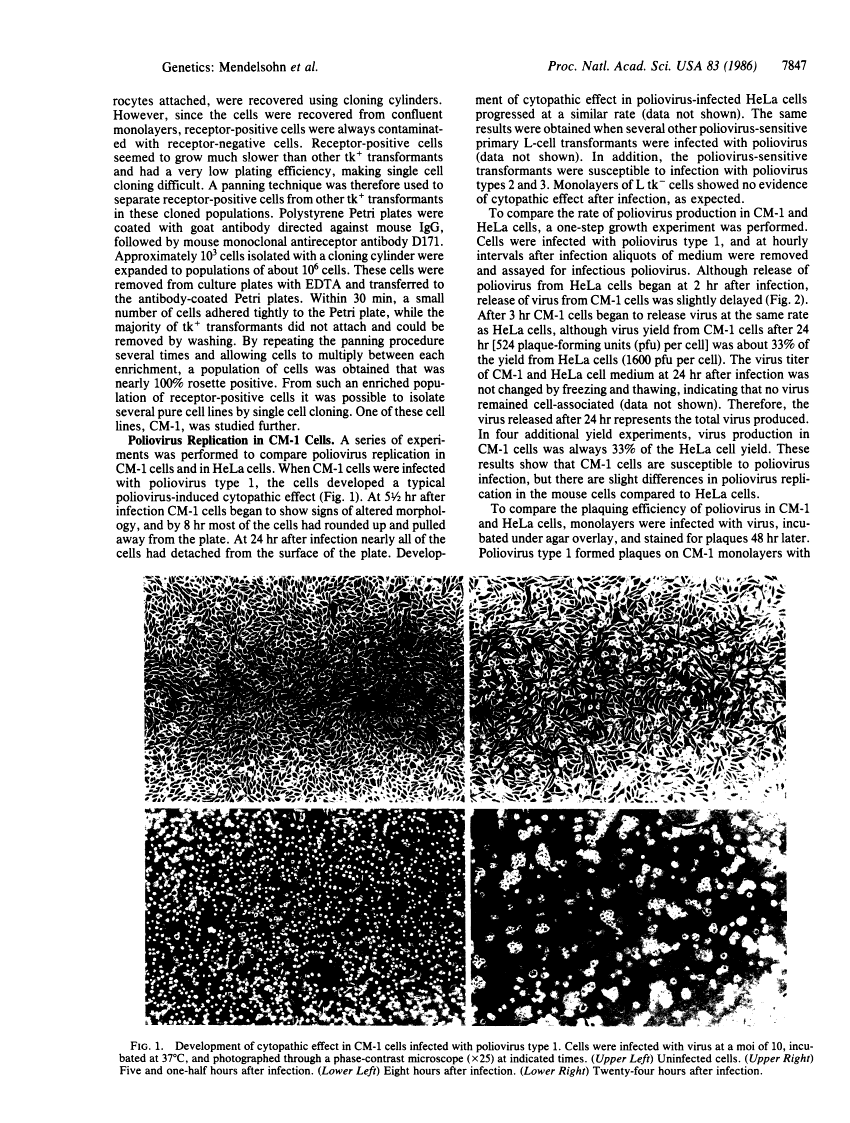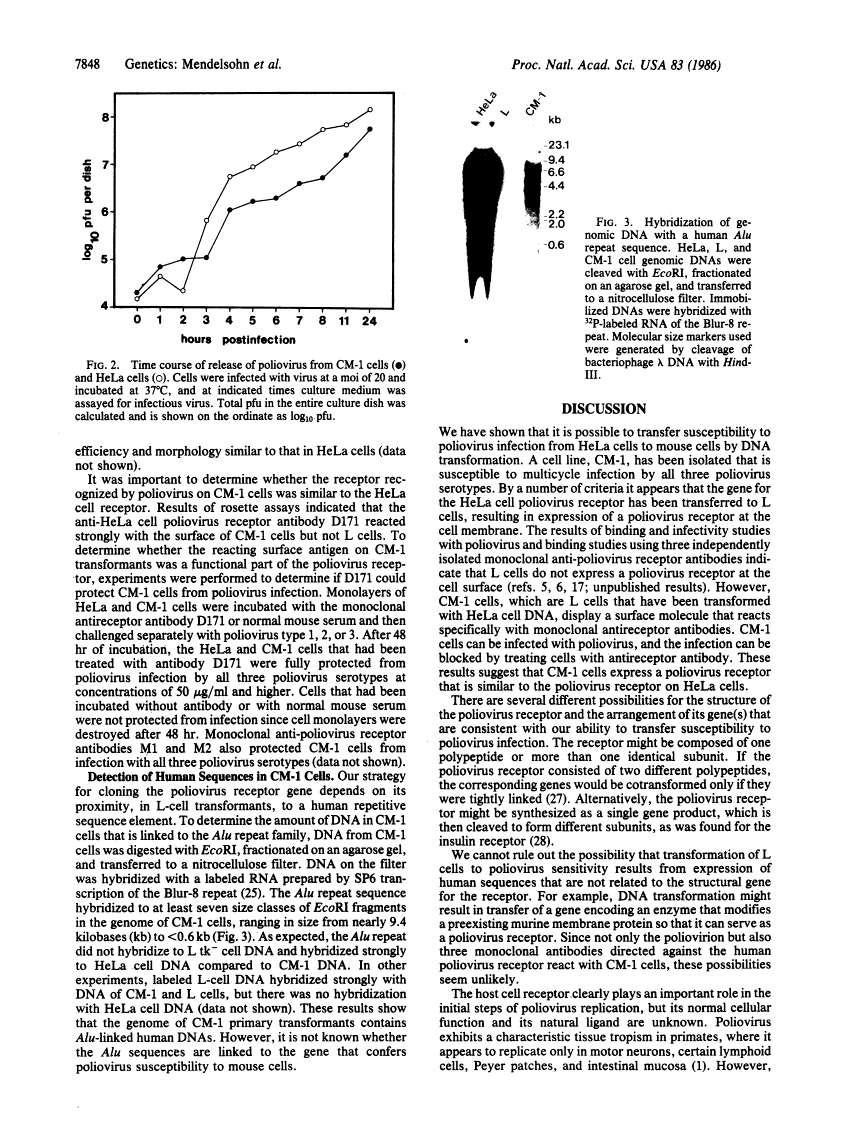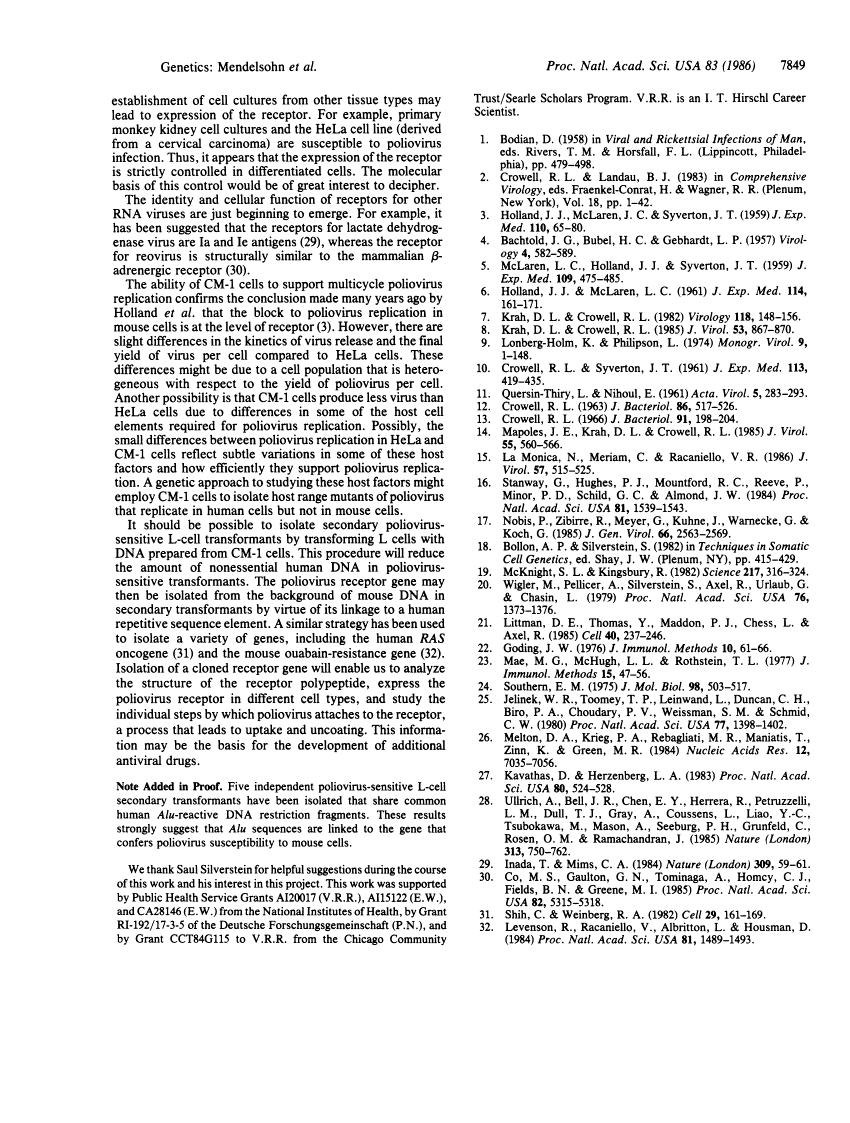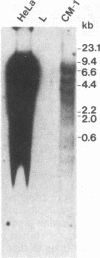Abstract
Free full text

Transformation of a human poliovirus receptor gene into mouse cells.
Abstract
The first step in poliovirus replication is binding of virus to a cellular receptor. Mouse L cells, which are resistant to poliovirus infection because they do not bear a poliovirus receptor, were transformed with HeLa cell (human) DNA to poliovirus sensitivity at a frequency of approximately 1 in 50,000 transformants. Monoclonal antibody directed against the HeLa cell poliovirus receptor site was used in rosette assays to identify poliovirus-sensitive L-cell transformants in a background of L-cell tk+ transformants. A cloned cell line, CM-1, was isolated that displayed a surface component recognized by the anti-poliovirus receptor antibody. CM-1 cells were susceptible to infection with all three poliovirus serotypes, and infection could be blocked by the antireceptor antibody. Poliovirus formed plaques in CM-1 and HeLa cells with equal efficiency. CM-1 and HeLa cells produced infectious poliovirus at a similar rate, although yield of virus in CM-1 cells was about 33% less than the yield in HeLa cells. These results suggest that DNA encoding the HeLa cell poliovirus receptor has been introduced into mouse cells, resulting in the expression of the receptor and susceptibility to poliovirus infection.
Full text
Full text is available as a scanned copy of the original print version. Get a printable copy (PDF file) of the complete article (1.7M), or click on a page image below to browse page by page. Links to PubMed are also available for Selected References.
Images in this article
Selected References
These references are in PubMed. This may not be the complete list of references from this article.
- HOLLAND JJ, McLAREN LC, SYVERTON JT. The mammalian cell-virus relationship. IV. Infection of naturally insusceptible cells with enterovirus ribonucleic acid. J Exp Med. 1959 Jul 1;110(1):65–80. [Europe PMC free article] [Abstract] [Google Scholar]
- BACHTOLD JG, BUBEL HC, GEBHARDT LP. The primary interaction of poliomyelitis virus with host cells of tissue culture origin. Virology. 1957 Dec;4(3):582–589. [Abstract] [Google Scholar]
- McLAREN LC, HOLLAND JJ, SYVERTON JT. The mammalian cell-virus relationship. I. Attachment of poliovirus to cultivated cells of primate and non-primate origin. J Exp Med. 1959 May 1;109(5):475–485. [Europe PMC free article] [Abstract] [Google Scholar]
- HOLLAND JJ, McLAREN LC. The location and nature of enterovirus receptors in susceptible cells. J Exp Med. 1961 Aug 1;114:161–171. [Europe PMC free article] [Abstract] [Google Scholar]
- Krah DL, Crowell RL. A solid-phase assay of solubilized HeLa cell membrane receptors for binding group B coxsackieviruses and polioviruses. Virology. 1982 Apr 15;118(1):148–156. [Abstract] [Google Scholar]
- Krah DL, Crowell RL. Properties of the deoxycholate-solubilized HeLa cell plasma membrane receptor for binding group B coxsackieviruses. J Virol. 1985 Mar;53(3):867–870. [Europe PMC free article] [Abstract] [Google Scholar]
- Lonberg-Holm K, Philipson L. Early interaction between animal viruses and cells. Monogr Virol. 1974;9:1–148. [Abstract] [Google Scholar]
- CROWELL RL, SYVERTON JT. The mammalian cell-virus relationship. VI. Sustained infection of HeLa cells by Coxsackie B3 virus and effect on superinfection. J Exp Med. 1961 Feb 1;113:419–435. [Europe PMC free article] [Abstract] [Google Scholar]
- CROWELL RL. SPECIFIC VIRAL INTERFERENCE IN HELA CELL CULTURES CHRONICALLY INFECTED WITH COXSACKIE B5 VIRUS. J Bacteriol. 1963 Sep;86:517–526. [Europe PMC free article] [Abstract] [Google Scholar]
- Crowell RL. Specific cell-surface alteration by enteroviruses as reflected by viral-attachment interference. J Bacteriol. 1966 Jan;91(1):198–204. [Europe PMC free article] [Abstract] [Google Scholar]
- Mapoles JE, Krah DL, Crowell RL. Purification of a HeLa cell receptor protein for group B coxsackieviruses. J Virol. 1985 Sep;55(3):560–566. [Europe PMC free article] [Abstract] [Google Scholar]
- La Monica N, Meriam C, Racaniello VR. Mapping of sequences required for mouse neurovirulence of poliovirus type 2 Lansing. J Virol. 1986 Feb;57(2):515–525. [Europe PMC free article] [Abstract] [Google Scholar]
- Stanway G, Hughes PJ, Mountford RC, Reeve P, Minor PD, Schild GC, Almond JW. Comparison of the complete nucleotide sequences of the genomes of the neurovirulent poliovirus P3/Leon/37 and its attenuated Sabin vaccine derivative P3/Leon 12a1b. Proc Natl Acad Sci U S A. 1984 Mar;81(5):1539–1543. [Europe PMC free article] [Abstract] [Google Scholar]
- Nobis P, Zibirre R, Meyer G, Kühne J, Warnecke G, Koch G. Production of a monoclonal antibody against an epitope on HeLa cells that is the functional poliovirus binding site. J Gen Virol. 1985 Dec;66(Pt 12):2563–2569. [Abstract] [Google Scholar]
- McKnight SL, Kingsbury R. Transcriptional control signals of a eukaryotic protein-coding gene. Science. 1982 Jul 23;217(4557):316–324. [Abstract] [Google Scholar]
- Wigler M, Pellicer A, Silverstein S, Axel R, Urlaub G, Chasin L. DNA-mediated transfer of the adenine phosphoribosyltransferase locus into mammalian cells. Proc Natl Acad Sci U S A. 1979 Mar;76(3):1373–1376. [Europe PMC free article] [Abstract] [Google Scholar]
- Littman DR, Thomas Y, Maddon PJ, Chess L, Axel R. The isolation and sequence of the gene encoding T8: a molecule defining functional classes of T lymphocytes. Cell. 1985 Feb;40(2):237–246. [Abstract] [Google Scholar]
- Goding JW. The chromic chloride method of coupling antigens to erythrocytes: definition of some important parameters. J Immunol Methods. 1976;10(1):61–66. [Abstract] [Google Scholar]
- Mage MG, McHugh LL, Rothstein TL. Mouse lymphocytes with and without surface immunoglobulin: preparative scale separation in polystyrene tissue culture dishes coated with specifically purified anti-immunoglobulin. J Immunol Methods. 1977;15(1):47–56. [Abstract] [Google Scholar]
- Southern EM. Detection of specific sequences among DNA fragments separated by gel electrophoresis. J Mol Biol. 1975 Nov 5;98(3):503–517. [Abstract] [Google Scholar]
- Jelinek WR, Toomey TP, Leinwand L, Duncan CH, Biro PA, Choudary PV, Weissman SM, Rubin CM, Houck CM, Deininger PL, et al. Ubiquitous, interspersed repeated sequences in mammalian genomes. Proc Natl Acad Sci U S A. 1980 Mar;77(3):1398–1402. [Europe PMC free article] [Abstract] [Google Scholar]
- Melton DA, Krieg PA, Rebagliati MR, Maniatis T, Zinn K, Green MR. Efficient in vitro synthesis of biologically active RNA and RNA hybridization probes from plasmids containing a bacteriophage SP6 promoter. Nucleic Acids Res. 1984 Sep 25;12(18):7035–7056. [Europe PMC free article] [Abstract] [Google Scholar]
- Kavathas P, Herzenberg LA. Stable transformation of mouse L cells for human membrane T-cell differentiation antigens, HLA and beta 2-microglobulin: selection by fluorescence-activated cell sorting. Proc Natl Acad Sci U S A. 1983 Jan;80(2):524–528. [Europe PMC free article] [Abstract] [Google Scholar]
- Inada T, Mims CA. Mouse Ia antigens are receptors for lactate dehydrogenase virus. Nature. 1984 May 3;309(5963):59–61. [Abstract] [Google Scholar]
- Co MS, Gaulton GN, Tominaga A, Homcy CJ, Fields BN, Greene MI. Structural similarities between the mammalian beta-adrenergic and reovirus type 3 receptors. Proc Natl Acad Sci U S A. 1985 Aug;82(16):5315–5318. [Europe PMC free article] [Abstract] [Google Scholar]
- Shih C, Weinberg RA. Isolation of a transforming sequence from a human bladder carcinoma cell line. Cell. 1982 May;29(1):161–169. [Abstract] [Google Scholar]
- Levenson R, Racaniello V, Albritton L, Housman D. Molecular cloning of the mouse ouabain-resistance gene. Proc Natl Acad Sci U S A. 1984 Mar;81(5):1489–1493. [Europe PMC free article] [Abstract] [Google Scholar]
Associated Data
Articles from Proceedings of the National Academy of Sciences of the United States of America are provided here courtesy of National Academy of Sciences
Full text links
Read article at publisher's site: https://doi.org/10.1073/pnas.83.20.7845
Read article for free, from open access legal sources, via Unpaywall:
https://europepmc.org/articles/pmc386819?pdf=render
Citations & impact
Impact metrics
Citations of article over time
Alternative metrics
Article citations
Cross-Reactive Antibody Responses against Nonpoliovirus Enteroviruses.
mBio, 13(1):e0366021, 18 Jan 2022
Cited by: 8 articles | PMID: 35038922 | PMCID: PMC8764532
Replication of SARS-CoV-2 in cell lines used in public health surveillance programmes with special emphasis on biosafety.
Indian J Med Res, 155(1):129-135, 01 Jan 2022
Cited by: 2 articles | PMID: 35859439 | PMCID: PMC9552391
Mechanisms of lymphatic system-specific viral replication and its potential role in autoimmune disease.
Clin Exp Immunol, 195(1):64-73, 01 Jan 2019
Cited by: 5 articles | PMID: 30444956
Review
Assessment of enteroviruses from sewage water and clinical samples during eradication phase of polio in North India.
Virol J, 15(1):157, 16 Oct 2018
Cited by: 15 articles | PMID: 30326921 | PMCID: PMC6192295
The expanding array of HIV broadly neutralizing antibodies.
Retrovirology, 15(1):70, 16 Oct 2018
Cited by: 34 articles | PMID: 30326938 | PMCID: PMC6192334
Review Free full text in Europe PMC
Go to all (42) article citations
Data
Similar Articles
To arrive at the top five similar articles we use a word-weighted algorithm to compare words from the Title and Abstract of each citation.
Functional domains of the poliovirus receptor.
Proc Natl Acad Sci U S A, 88(10):4104-4108, 01 May 1991
Cited by: 56 articles | PMID: 1851992 | PMCID: PMC51606
Poliovirus mutants resistant to neutralization with soluble cell receptors.
Science, 250(4987):1596-1599, 01 Dec 1990
Cited by: 41 articles | PMID: 2177226
Isolation and characterization of HeLa cell lines blocked at different steps in the poliovirus life cycle.
J Virol, 63(1):43-51, 01 Jan 1989
Cited by: 29 articles | PMID: 2535745 | PMCID: PMC247655
Poliovirus and its cellular receptor: a molecular genetic dissection of a virus/receptor affinity interaction.
J Mol Recognit, 11(1-6):2-9, 01 Jan 1998
Cited by: 8 articles | PMID: 10076797
Review
Funding
Funders who supported this work.
NCI NIH HHS (1)
Grant ID: CA28146
NIAID NIH HHS (2)
Grant ID: AI20017
Grant ID: AI15122
